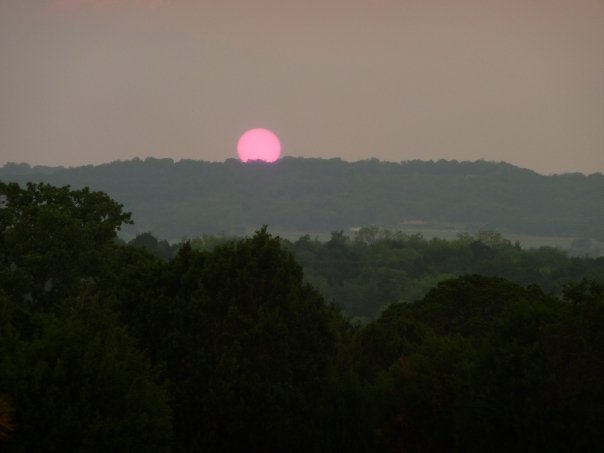
This photo was taken from the front yard of a friend of a friend’s home in Mineral Wells,Texas and it fascinated me and inspired me to ask “Why”. I love things that move me to investigate and learn. There is something quiet romantic about a pink moon. How beautiful I thought, I wondered what causes that color illusion. Blue moons are caused by dust and ash particles in the air perhaps something similar causes the pink color. I researched and googled and all I could come up with was the history you see below from the Farmers Almanac. There were mentions of Pink Floyd (whom I love) and Nick Drake who wrote song lyrics for Pink Moon (use the link to hear it) a few business names and nothing else. What do I tell my grand kids when they ask “Grandma why is the moon pink”. I don’t want to just shrug my shoulders and look clueless. I’m the cool grandma with all the answers and I want a logical and scientific answer to this question, not the folklore you see below. So to all you astronomers I am asking “Why is the moon pink”.
A Full PINK Moon
April is known for its showers and ever-warming temperatures, but it is also known as a month when spring flowers begin to show up. Herb moss pink, or wild ground phlox, is one of the earliest widespread flowers of the spring. As the name infers, the flowers are pink in color, thus the name for April’s full moon.
one of the earliest widespread flowers of the spring. As the name infers, the flowers are pink in color, thus the name for April’s full moon.
This pink moon has also been called: the full sprouting grass moon, the egg moon, and among coastal tribes, the full fish moon, because this was the time that the shad swam upstream to spawn.
In 2009, the full pink moon is also the full paschal moon which helps set the date for Easter. Easter is determined as being the first Sunday following the first full moon that occurs on or after the day of the vernal (spring) equinox.



















Pink moons are as rare as blue ones and probably caused by the same phenomenon – dust and pollution in the atmosphere. The most recent displays might be caused by Australia’s recent bush fires. The bush fires released an enormous amount of pollution (carbon dioxide) which is probably dispersing across the globe even now. Still, must have been a gorgeous sight.
I don’t think I’ve ever seen a pink moon! How cool is that?!
When asked questions like this, I always think of Morgan Freeman’s character in Robin Hood: Prince of Thieves. When asked why he’s “painted” (a.k.a. black), he responds to the child, “Because Allah loves wonderous variety!”
I like that movie and that answer but can you imagine my 5 year old grandson’s face if I said it to him. I think I would like to say that and then follow up with the science behind it.
I don’t think I’ve ever seen a pink moon ever! I remember when I saw an eclipse of the moon. I was so fascinated!
Southern California has pink moons, red moons, and gold moons. It’s due to the pollution. Not very romantic, but I’ve been playing with a story idea of creating a myth of a post-apoclyptic people trying to figure out why the moon is one color when it rises and sets and another when it’s high in the sky.
Of course, someone smarter than me might just have a better explination.
I love the fact that you want an answer.
It probably is the pollution in Texas or California but there still is a scientific reason behind it and I want to know details.. The story sounds interesting, can’t wait to hear more.
they always occur when the Sun or Moon is close to the horizon. If you think about it, sunlight or moonlight must travel through the maximum amount of atmosphere to get to your eyes when the Sun or Moon is on the horizon (remember that that atmosphere is a sphere around the Earth). So, you expect *more* blue light to be scattered from Sunlight or Moonlight when the Sun or Moon is on the horizon than when it is, say, overhead; this makes the object look redder. In other words, the Sun or Moon tends to look orange or red or pink when it is rising or setting because that’s the time when the light has to travel through the most atmosphere to get to you. The effect is exacerbated when there are thin clouds in front or behind the Sun or Moon: the clouds themselves often glow bright pink as well, because they are so good at scattering blue light.
so, you’re right. it’s the same as with the blue moon!!
I’m staring blankly because I don’t have a clue as to what you just said, so I know it must be true. Thank you mcdawnie, now I have to break it down so my 5 year old grandson can understand. Atmosphere, light, scatter, horizon, got it, maybe.
Here are some other kinds of moons! :)
I love that you look for the scientific answer. As a former scientist I love this approach and I strive to instill it in my children.
It’s a fascinating world we live in…
What a beautiful picture. I’ve never seen a pink moon. Occasionally around here, we have a beautiful red-orange moon. Thanks so much for the kind note you emailed me. Makes it all worthwhile.
Well, we experienced a pure pink moon last night here in southwest Turkey. Astronomical spectroscopy uses high-dispersion diffraction gratings to observe spectra at very high spectral resolutions, i.e. based on the spectrum of colour they emit or absorb. The shifting of spectral lines can be used to measure the red shift or blue shift of distant or fast-moving objects, these two colours being at opposite ends of the colour spectrum.
The moon’s color changes based on changes that occur in the Earth’s atmosphere. Above the atmosphere, in space, the environment is very clear, with few dust particles, little time-space distortion and nothing to get in the way of light traveling from the sun to the moon—and from the moon to the earth, as a percentage of the light is reflected on the moon’s surface. Up to a certain point, this light remains undistorted, and we see the best example of this when the moon is directly above the earth and shining with its famous pale-light color.
However, when this light hits the atmosphere, it starts to be disrupted by several different effects, including water vapor, dust particles and angles of view. When the moon is high in the sky, its reflected light passes through a minimal number of these disturbances and the moon appears in various shades of white. However, at different angles and low in sky, the light has to pass through many more of these disruptive factors, which can change both the apparent shape and color of the moon.
In principle, this effect is very similar to the way sunlight changes as it enters our atmosphere. Direct light from the sun is a very bright white or yellow because it passes through the smallest amount of particles and reaches the earth most clearly. Scattered sunlight passes through more particles and turns the sky blue, while the sun at dawn and dusk is level with the horizon and has to pass through a large portion of the atmosphere to be seen by the human eye, changing the color to various shades of red and orange.
All these changes are due to the properties of light and the way it is refracted. Pure light from the sun and moon is made of a wide spectrum of visible light waves, many different colors combined to look white or yellow-white. As this wide-spectrum light hits particles of dust, it bounces off of them, but some spectrum shades are absorbed by the particle, leaving a “smaller” light wave with fewer combined colors to continue traveling through the air. When the light hits a particle of water vapor, it passes through but is refracted off the water molecules, some colors splitting off and traveling in different directions with other colors, generally those with the longest wavelengths, continuing onward. The more atmosphere the light has to travel through, the more particles it runs into and the more often this refraction occurs.
In the end, the light that has the longest wavelengths and has the easiest time traveling straight tends to arrive and be absorbed by the viewer’s eyes. In the light produced by the sun, the blue, red and orange light waves are the longest in the available spectrum and tend to travel the farthest. When the moon is close to the horizon or has to pass through a lot of dust, these are the light waves that make it through to be seen, making the moon appear to be reddish or orange in color. Since blue also has a long wavelength, sometimes the moon, like the sky itself, appears blue, this being the primary color of light to reach our eyes on certain occasions.
I saw a pink moon tonight did a search and found this posted a while back the answer about it being close to the horizon fits the one I saw as it was just above the tree line.
What a wonderful post.
I also could find nothing aside from Pink Floyd and Nick Drake… and then this popped up. I’m always looking for reasons behind the natural phenomenon we occasionally see. Every so often you learn something that is just so mindbogglingly strange and brilliant, that I feel like an explorer in search of treasure.
Ever heard of the Belt of Venus? You probably have seen it, but did not know the name. Remember looking at the sky near sunset? Look to the east and often you can see a pinkish color band across the sky. Right below that is a darker usually blue to gray band. That gray band is the earth’s shadow! Cool huh? This is the Belt of Venus. IIt occurs in the morning too (opposite side of course). Anyway, when the moon rises at a time that makes it go through the pink part of the sky, you have a pink moon :) That is it in a nutshell.